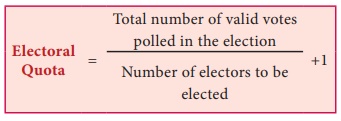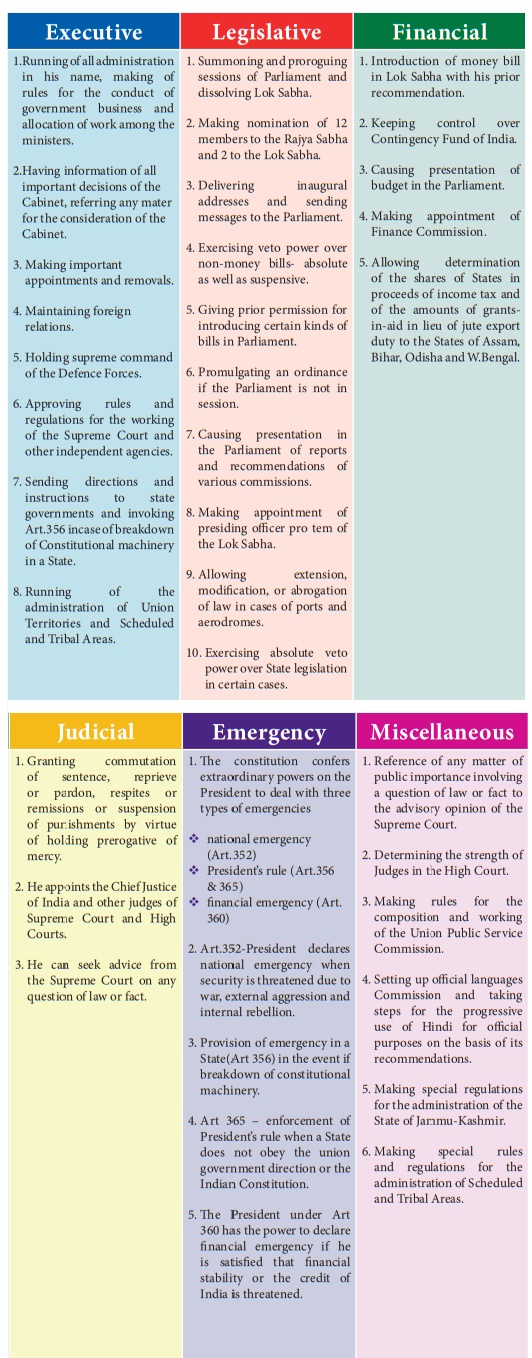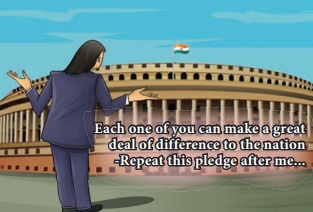Qualification, Election, Functions, Powers of the President - President | 12th Political Science : Chapter 3 : Executive
Chapter: 12th Political Science : Chapter 3 : Executive
President
President
The President is the head of the Indian State. He
is the First Citizen of India and acts as the symbol of Unity, Integrity and
Solidarity of the Nation.
Qualification and Election of the President
Article 58 says;
1. NO person shall be eligible for election as
President unless he is
•  acitizen of India
•  has completed the age of 35 years
•  isqualified for election as a member of the Lok Sabha
2. A person shall not be eligible for election as
President if he holds any office of profit under the government of India, or
the government of any state, or under any local or other authority subject to the
control of any of the said governments.
Article 52 of our Constitution lays down that there shall be a
President of India. Article 53 lays down that the executive power of the Union
shall be vested in the President and shall be exercised by him directly or
indirectly.
Further Article 52 provides that the nomination of
a candidate for election to the office of President must be subscribed by at
least 50 electors as proposers and seconded by another 50 electors of the
Electoral College. Every candidate has to make a security deposit of â‚ą15,000/- in the Reserve Bank of
India.
This amount will be forefeited if the candidate
does not secure 1/6 of the votes polled.
The President is elected not directly by the people
but by members of Electoral College consisting of:
•  The elected members of both the houses of Parliament
•  The elected members of the legislative assemblies of the states
•  The elected members of the legislative assemblies of the union territories of Delhi and Pondicherry.
The President`s election is held in accordance with
the system of proportional representation by means of single transferable vote
and the voting is by secret ballot. This system enures that the successful
candidate is returned by the absolute majority of votes.

Each member of the electoral college is given only
one ballot paper. The voter, while casting his vote, is required to indicate
his preferences by marking 1,2,3,4 etc against the names of the candidates.This
means the voter can indicate as many preferences as there are candidates in the
fray. In the first phase, the first preference votes are counted. In case a
candidate secures the required quota in this phase, he is declared elected. Otherwise,
the process of transfer of votes is carried out. The ballots of the candidate
securing the least number of first prefrence votes are cancelled and his second
preference votes are transferred to the first preference votes of other
candidates.This process continues till a candidate secures the required quota.
Oath by the President
Before entering upon his office, the President has to
make and subscribe an oath or affirmation. In his oath, the President swears:
•  TO faithfully execute the office;
•  TO preserve, protect and defend the constitution and the law; and
•  TO devote himself to the service and wellbeing of the people of India.
The oath of office to the President is administered
by the Chief Justice of India and in his absence in the presence of the senior
most judge of the Supreme Court.
Entitlement to the President
• He is entitled without payment of rent to use his official residence (The Rashtrapathi Bhavan-Dehil)
• He is entitled to such emoluments, allowances and privileges as may be determined by the Parliament
• The President is entitled to a number of privileges and immunities. He enjoys personal immunity from
legal liability for his official acts. During his term of office, he is immune
from any criminal proceedings
Term, Impeachment and Succession
Term
Article 56 says that the President shall hold
office for a term of 5 years from the date on which he enters upon his office.
However, he can resign from his office at any time by addressing the
resignation letter to the Vice-President. Further he can also be removed from
the office before completion of his term by the process of impeachment. The
President can hold office beyond his term of five years until his successor
assumes charge. He is also eligible for re-election to that office.
Impeachment
Article. 61 of the Constitution lays down a
detailed procedure for the impeachment of the President. For the impeachment of
the President, first, a charge for impeachment has to be made in either House
of the Parliament by a resolution signed by atleast one fourth of the total
number of members of the House and moved by giving atleast 14 days’ advance
notice. Such a resolution must be passed by a majority of not less than two thirds
of the total number of members of the House when a charge is so presented by
one House, it should be investigated by the other House. After the
investigation, if a resolution is passed by the other house by a majority of two
thirds of its total number of members, the President stands removed by
impeachment from his office from the date of passing of the resolution.
Succession
A vacancy in the President’s office can occur in
any of the following ways:
1. On the expiry of his tenure of five years
2. By his resignation
3. On his removal by impeachment
4. By his death
5. When he becomes disqualified to hold office or
when his election is declared void.
If the vacancy occurs due to resignation, removal
or death, then election to fill the vacancy should be held within six months
and the Vice-President will act as the President until a new President is
elected. Further, when the sitting President is unable to discharge his
functions due to absence, illness or any other cause, the Vice-President
discharges his functions until the President resumes his office. In case the
office of the Vice-President is vacant, the Chief Justice of India or if his
office is also vacant, the senior most judge of the Supreme Court acts as the
President or discharges the functions of the President.
Functions and Powers of the President
Vast are the functions and powers of the President.
He convenes the parliament, addresses and prorogues the same. He nominates 12
members of eminence in different fields to the Rajya sabha and two Anglo Indian
members to the Lok Sabha. He enjoys veto power over non-money bills of the
parliament and can send back non-money bills for reconsideration of the
parliament, he can convene joint sessions of Rajya Sabha and Lok Sabha; He can
promulgate ordinances for a period not exceeding six months. He can also has veto
powers over certain State legislations. He prompts and facilitates the
institution of Council of Ministers headed by the Prime Minister, and ensures
that the council of Ministers enjoy the support of the majority in the Lok
Sabha. The President alone installs the ministers and distributes portfolios to
them, he can also, dismiss the ministry, if he feels that the ministry does not
enjoys the majority support in the Lok sabha. He nominates members to various
constitutional bodies, including the judiciary, armed forces and diplomatic
corps. The President enjoys enormous powers during the periods of emergencies,
can suspend any law, can dissolve ministries and legislatures for specified
periods. He can also commute capital punishments.

Fact
The emergency powers of the President
of India are specified in Part XVIII of the Indian Constitution.
When any person i.e., Vice-President,
Chief Justice of India or senior most Judge is acting as President, he enjoys
all the powers and immunities of the President as is entitled to such
emoluments, allowances and privileges as determined by the Parliament.
The Official Residence of the President of India is
“The Rashtrapathi Bhavan” situated at
Delhi……..
Activity
Find out the electoral quota if the
total number of voters polled in the election for President is 10,00,000 and
the number of candidates to be elected is 1
Debate
We have a written constitution
wherein the functions and responsibilities of each constitutional office are
clearly defined and delimited. We are a Republic with an elected President as
the Head of the State. But we are also a Parliamentary democracy with
Ministerial responsibility to the representatives of the people in the Lok
Sabha.
Teacher can divide the class into two
group and organise a debate on the unique mix of the President and the Prime
Minister and his team.
Activity
Read The Cartoon Identify The Context.

1. What is being
depicted by the given cartoon?
Activity
1. Discuss the Veto
Powers of the President of India.
2. Find out what is
Absolute Veto, Suspensive Veto, Pocket Veto and Qualified Veto.
List out all the
Presidents and their tenure till date. Make a Collage using the images
collected.
Preparation of Chart
List the Prime Ministers of India from 1947 to 2019. Paste the photos of the Prime Ministers in your chart.
Activity
Identify the powers of the President, related to the
examples in the given tabular column
(executive/legislative/ judicial/financial/emergency)

Related Topics